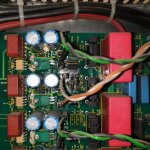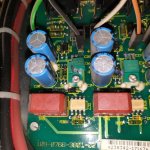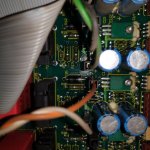;=========================================================
; MP 3000 .. 3999
; SPINDLE-CONTROL
;=========================================================
; SPINDLE-SPEED O/P,SPINDLE ORIENTATION
; 0 = NO OUTPUT OF SPINGLE RPM
; 1 = CODED , ONLY IF RPM CHANGES
; 2 = CODED , WITH EACH TOOL
; 3 = S-ANALOG, GEAR SWITCH SIGNAL ONLY IF GEAR CHANGES
; 4 = S-ANALOG, GEAR SWITCH SIGNAL WITH EACH TOOL CHANGE
; 5 = S-ANALOG, WITHOUT GEAR SWITCHING SIGNAL
; 6 = S-ANALOG+ORIENTATION, GEAR S/W SIGNAL IF GEAR CHANGE
; 7 = S-ANALOG+ORIENTATION, GEAR S/W SIGNAL WITH TOOL CHANGE
; 8 = S-ANALOG+ORIENTATION, WITHOUT GEAR S/W SIGNAL
MP 3010 : 7
; SPECIAL FUNCTION O/P IF MP3010<3
; 0 = NO SPECIAL FUNCTION
; 1 = O/P VOLTAGE PROPORTIONAL TO FEEDRATE
; 2 = O/P VOLTAGE GOVERNED BY PLC
; FEEDRATE FOR OUTPUT OF 10 VOLTS (MP3011=1)
; LIMIT RPM CODE (0 - 99999)
MP 3020 : 1991
; AXIS STANDSTILL ON TOOLCALL WITH SPINDLE O/P
MP 3030 : 0 ;0=AXIS HALT/1=NO AXIS HALT
; PROGRAMMING THE RPM S=0
MP 3120 : 0 ;0=PERMITTED 1=NOT PERMITTED
; POLARITY S-ANALOGUE
; 0=BIPOLAR, M3=POS./M4=NEG.
; 1=BIPOLAR, M3=NEG./M4=POS.
; 2=UNIPOLAR POSITIVE
; 3=UNIPOLAR NEGATIVE
MP 3130 : 1 ; COUNTING DIRECTION OF SPINDLE ENCODER
MP 3140 : 1 ;0=POS./1=NEG.
; ANALOGUE VOLTAGE FOR GEAR RANGES(0 - 9.999 VOLT)
MP 3210.0 : 9,999 ;GEAR RANGE 0
MP 3210.1 : 9,999 ; 1
MP 3210.2 : 0 ; 2
MP 3210.3 : 0 ; 3
MP 3210.4 : 0 ; 4
MP 3210.5 : 0 ; 5
MP 3210.6 : 0 ; 6
MP 3210.7 : 0 ; 7
;REGULATING RANGE FOR S-ANALOG (0 - 9.999 VOLT)
MP 3240.1 : 0,01 ;MINIMUM ANALOGUE VOLTAGE
MP 3240.2 : 0,05 ;VOLTAGE DURING GEAR CHANGE
; LIMIT S-OVERRIDE (0 - 150 %)
MP 3310.0 : 120 ;MAXIMUM
MP 3310.1 : 50 ;MINIMUM
; RAMP SLOPE FOR S-ANALOG (0 - 1.999 V/MS)
MP 3410.0 : 1,999 ; M03/M04
MP 3410.1 : 0,5 ; SPINDLE ORIENTATION
MP 3410.2 : 0,1 ; TAPPING CYCLE
MP 3410.3 : 0 ; RIGID TAPPING
; POSITION WINDON FOR SPINDLE 1 INCREMENT=0,088 DEGREE)
MP 3420 : 10 ; SPINDLE-PRESET (0 - 360 DEGREE)
MP 3430 : 0 ; KV-FACTOR FOR SPINDLE ORIENTATION (0.1 - 10)
MP 3440.0 : 0,8 ;GEAR RANGE 0
MP 3440.1 : 0,8 ; 1
MP 3440.2 : 0,1 ; 2
MP 3440.3 : 0,1 ; 3
MP 3440.4 : 0,1 ; 4
MP 3440.5 : 0,1 ; 5
MP 3440.6 : 0,1 ; 6
MP 3440.7 : 0,1 ; 7
; RPM FOR GEAR RANGES (0 - 99999.999)
MP 3510.0 : 1000 ;GEAR RANGE 0
MP 3510.1 : 4000 ; 1
MP 3510.2 : 0 ; 2
MP 3510.3 : 0 ; 3
MP 3510.4 : 0 ; 4
MP 3510.5 : 0 ; 5
MP 3510.6 : 0 ; 6
MP 3510.7 : 0 ; 7
;MAX RPM LIMIT FOR GEAR RANGES (0 - 99999.999)
MP 3515.0 : 1000 ;GEAR RANGE 0
MP 3515.1 : 4000 ; 1
MP 3515.2 : 0 ; 2
MP 3515.3 : 0 ; 3
MP 3515.4 : 0 ; 4
MP 3515.5 : 0 ; 5
MP 3515.6 : 0 ; 6
MP 3515.7 : 0 ; 7
; SPINDLE SPEED FOR ORIENTATION (0 - 99999.999)
MP 3520.0 : 0 ;RPM IF M2501 SET
MP 3520.1 : 50 ;RPM SPINDLE ORIENTATION





